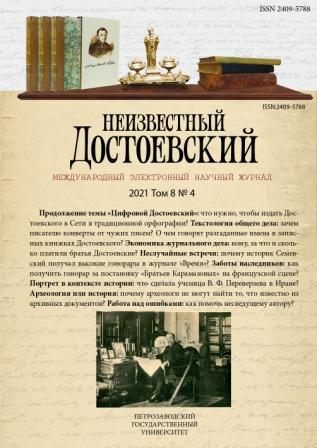«Отвечать»: записи и пометы Достоевского на письмах и конвертах его корреспондентов
“To Answer”: Dostoevsky’s Notes and Marks on Letters and Еnvelopes of His Correspondents
Author(s): Irina Svyatoslavovna AndrianovaSubject(s): Media studies, Russian Literature, 19th Century, Philology, Theory of Literature
Published by: Петрозаводский государственный университет
Keywords: F. M. Dostoevsky; letter; correspondent; addressee; reader; note; marginalia; “A Writer’s Diary”; textual criticism; dialogue; creative process; draft;
Summary/Abstract: F. M. Dostoevsky received a huge amount of correspondence, especially in the 1870s — the time of the publication of the “A Writer’s Diary.” More than 1,600 letters to the writer from over 500 addressees have been preserved. This volume is comparable only to the correspondence of L. Tolstoy in the 1880s — 1890s, responding to which required the help of numerous assistants. Dostoevsky did not have the opportunity to answer all the letters, but tried not to ignore the correspondence from his readers. His work with the received letters is evidenced by the notes and marks (including non-textual ones) made on them. They are systematized in “The Handwritten legacy of F. M. Dostoevsky” (2021) and analyzed in this article. 109 of Dostoevsky’s notes were revealed on the letters of his addressees of 1859–1881, three of them for the first time: on the envelopes of letters from O. A. Antipova’s letters of May 7, 1877, from Prince N. N. Golitsyn’s of February 9, 1878, and on the sheet from D. A. Insarsky’s letter of August 14, 1864. The systematization of the writer’s notes and marks on the letters of his correspondents allowed to classify them in three groups. These are records containing information about the addressees and their letters, made by the author of “A Writer’s Diary” immediately after reading the letters; rough drafts of works; records for memory (addresses, lists of personal effects, monetary calculations related to the publication of works). In the process of working on the description of Dostoevsky’s notes, the text of some entries was clarified, and mistakes made in the academic “Complete Works” of the writer (the initials of the addressees, the dating of letters, etc.) were corrected. Dostoevsky’s notes and marks on the letters of his correspondents reflect his creative process, details of everyday life and publishing activities, and the author’s lively dialogue with readers.
Journal: Неизвестный Достоевский
- Issue Year: 8/2021
- Issue No: 4
- Page Range: 21-37
- Page Count: 17
- Language: Russian

